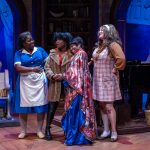Hearing the Renaissance clearly
Stile Antico sang on the Early Music Now series Saturday evening and deepened my understanding of Renaissance polyphony.
I love it when that happens.
The 13 young British singers built their program around the Puer Natus Est Mass, which Thomas Tallis composed in 1542. Tallis followed Renaissance practice by making a Gregorian chant — in this case Puer Natus Est (A Boy Is Born) — the common thread for all the movements of his Christmas-season mass.
This mass, in seven-part counterpoint, is brainy stuff. Tallis followed the modal theory of his time, which governed voice-leading and constrained harmony. He made it a little tougher on himself by using numerology based on the Latin vowels in the source chant to determine rhythmic values of that chant as it threads its way through the mass. All Renaissance masses are like puzzles, as composers strove to weave imitative music into webs of inversion, retrograde, transposition, diminution, augmentation and so on, while dodging dissonances deemed unholy. Writing a mass with seven independent vocal lines is rather like designing the world’s most complex freeway interchange, under the requirement that it must be as beautiful as it is functional.
Stile Antico, along with the congenial acoustic of the Cathedral of St. John the Evangelist, showed me that my approach missed the point. The intellectualized compositional process yields a hypnotic, dream-state sort of listening experience. Its affect is more akin to Minimalism that to the polyphony of Bach. This music doesn’t go anywhere; in the proper acoustical environment, its glowing, ever-shifting sonic weave surrounds you. You enter into a state of heightened awareness in which musical analysis on the fly is irrelevant. Just let it be.
Stile Antico tuned and blended perfectly and sang with a pure tone just right for this music. The singers made it easy to enter into the music. To let it be.
They interspersed Tallis’ mass movements with a couple of plainchants and shorter works, all with texts related to the Nativity, by William Byrd, Robert White, and John Sheppard. White’s (1538-1574) Magnificat stood out. This forward-looking composer shows a prescient interest in dissonance for expressiveness and shock value. It required a different listening strategy from the rest and a more pointed approach to singing by Stile Antico. The exception both proved the rule and helped us understand it.
This concert completely sold out the spacious cathedral. Early Music Now is becoming something of a hot ticket, for a lot of good reasons. If you’re interested in attending the remaining three EMN programs this season, you should probably get your tickets now. Call 414 225-3113 or visit the EMN website.


















in renaissance music, the interventions, which are a key focus, are like a sound wand, bringing to the fore incantatory effects which can in truth seduce the listener nearer to the the foaming cauldron than towards the helix of weightless incense.
This provocative review brings up a question I have often pondered when I hear this type of music: what is the “right way” to listen to it? The easy answer (and probably the right one) is that there is no”right” way. A scholar of Renaissance polyphonic music who hears some or all of the stuff you mention ( the points of imitation, the retrogrades, the elongated cantus firmi, etc) isn’t listening in a” better” way than the a local viola player who lets, as you say” the music “be”. The musicologist and the viola player are simply taking different routes to get to the plethora of wonders that the music holds. I will put forward this idea however: when you get a group together to sing or play this this music from a score, (rather than passively hearing it performed) it does let you start to see the cool stuff that is going on. And that is an inimitable experience. I’m wondering (and this is probably “over the top”) that an argument could be made that by presenting this music one time in in a public performance, lots of people are entertained and/or aesthetically moved (which is a great thing in itself) but that sort of presentation is not necessarily doing full justice to the actual music. No doubt it is too extreme (but I’ll suggest it anyway) that to really get to the core of what’s going on in the music, there is a more direct route: sing it, play it, rehearse it with each performer working FROM A SCORE. If you don’t play gamba or recorders, then sit down with the score and listen many times to a recorded performance. Scholastic as it sounds, that too can get you to the top of Mt. Parnassus. Apologies, Tom, for being so long-winded. Let me end by saying that your review does exactly what a good music review should do: it provokes questions, not only about the music being reviewed, but also about something more: the experience of listening to music.
Jonathan, thanks very much for your thoughtful comments. This is just the sort of discussion I hope for at our site.
It made me imagine a lecture-demo in which a choir sings a piece whole, then breaks it down to expose the cantus firmus and all the contrapuntal devices and show how they interact, with the score and specific parts projected to illustrate. That would be fascinating, and not all that hard to do, technically.
OK, that’s my $1,000,000 idea for the day. — Strini